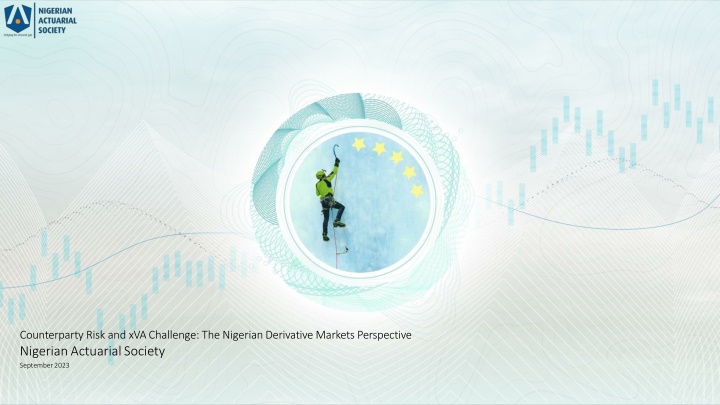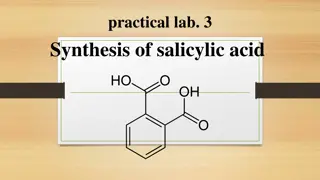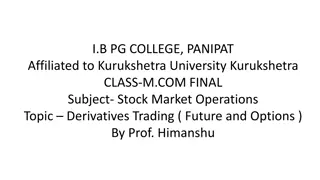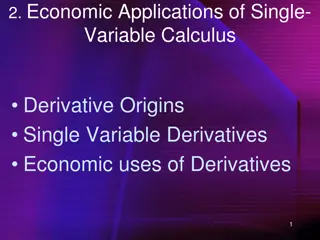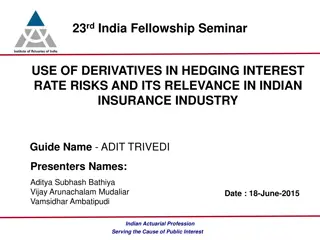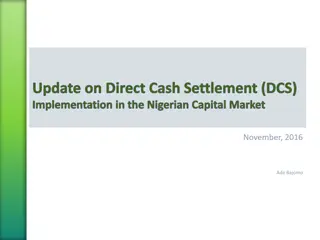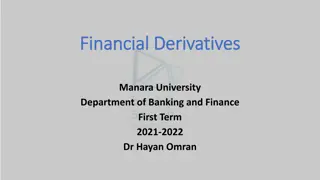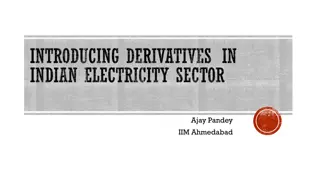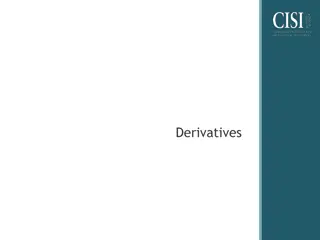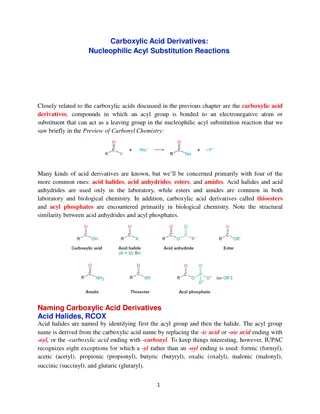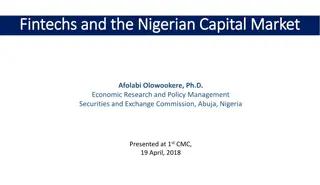Nigerian Derivatives Market Regulations
Nigeria's derivative market has seen significant growth, marked by regulatory developments and the introduction of new products. Explore the evolution of the market, recent regulations, and key players shaping the landscape.
Download Presentation

Please find below an Image/Link to download the presentation.
The content on the website is provided AS IS for your information and personal use only. It may not be sold, licensed, or shared on other websites without obtaining consent from the author.If you encounter any issues during the download, it is possible that the publisher has removed the file from their server.
You are allowed to download the files provided on this website for personal or commercial use, subject to the condition that they are used lawfully. All files are the property of their respective owners.
The content on the website is provided AS IS for your information and personal use only. It may not be sold, licensed, or shared on other websites without obtaining consent from the author.
E N D
Presentation Transcript
Counterparty Risk and xVAChallenge:TheNigerianDerivativeMarketsPerspective NigerianActuarialSociety September2023
Contents Introduction 3 NigerianDerivativeMarket 6 DerivativeinInsuranceIndustry 7 CounterpartyRiskVsLendingRisk 8 MitigatingCounterpartyRisk 9 10 CreditValueAdjustments(CVA) IFRS13 RequirementforCVA 11 MeasuringCVA 12 2
Introduction A derivative is a security with a price that is derived from one or more underlyingassets. VALUEOF THE DERIVATIVEIS DETERMINED BY THE FLUCTUATIONSIN THE UNDERLYING ASSET !!! the underlying assets may be stocks, bonds, currenciesor interest rates
Introduction Derivatives are held for different reasons and there are different types of derivatives a party can have Forwards Futures HedgeRisk Derivativeshavebeen popular in the physical market. The aim of using derivatives is to minimize risk (similar to insurance policies) Swaps Speculation Options Maybe a more popular application of derivativesis to make profit
Introduction Since 2011, when the Central Bank of Nigeria (CBN) released the Guidelines for Foreign Exchange Derivatives and Modalities for CBN Foreign Exchange (FX) Forwards, the Nigerian derivatives markethas grownsteadily. FMDQ Exchange is a pioneer in the Nigerian financial markets for organising Derivatives markets. Theyaretwo tradedderivativeson FMDQ OTC Derivativesand ExchangeTradedDerivatives In 2014, FMDQ Group Plc began publishing data on turnover of products traded on its platform. Based on the data published by FMDQ Group Plc, the market turnover for foreign exchange derivativeson the FMDQ platformgrew from 6.5 trillionNigeriannairain 2014to 28.7 trillionnaira In 2022, Nigerian Exchange Limited (NGX) launched West Africa s first Exchange Traded Derivatives (ETD) market with Equity Index Futures Contracts. 5
NigerianDerivative Market Nigeria's derivatives regulatory framework has evolved alongside the growth of the market. A sound and efficient derivatives market requires the presence of appropriate comprehensive and flexible laws, and financial market regulators have recently ramped up regulatory activity aimed at achieving this. This article highlightssomerecent regulatory developmentsintheNigerian derivativesspace SEC'sissuanceof exchange traded derivatives andCCP rules Increasedlengthof OTCFXfutures contracts DevelopmentswithinFMDQGroup The Securities and Exchange Commission (SEC) released rules governing exchange- traded and OTC derivatives trading in Nigeria. The first set of rules highlight requirements for derivativestradingin Nigeria,(derivatives trading rules). The secondset of rules highlight requirements for the establishment and operation of centralclearing counterparties in Nigeria(CCPrules). The Central Bank of Nigeria (CBN) in collaboration with FMDQ Holdings Plc offered its first long-term Naira settled OTC FX Futures Contracts to hedge againstforeign exchange (FX) risk, with a maximum tenor of 5 years and to be traded on the FMDQ OTC Securities Exchange he reference rate for all open NSOFF contracts was revised such that NSOFF contracts with terms to maturity greater than eight days would be valued using rates to be quoted by the CBN. December2021 February 2020 2019 the SEC approved the Nigerian Exchange Limited (NGX) Rulebook on Derivatives Market (the rulebook). The rulebook became effective on 14 April 2022 and applies to all the members of the NGX and users of the NGX derivatives platform The SEC issued the Rules on Warehousing and Collateral Management (warehouse rules) to set out registration and operational requirements of warehouses and collateral managers, which are integral functions for the establishment of commoditiesderivativescontracts August2019 March2021 Issuanceof derivatives rulebook by NGX Developments in commodities derivatives markets 6
Derivativesin InsuranceIndustry U.S.Insurance IndustryDerivative Exposures 50.6% 98.3% 69% Life companies accountedfor 98.3% of the industry s notional value of derivativesexposure 69% of total number of U.S. insurers with derivativeexposure. Swapsaccountedfor 50.6% of total derivativeexposure Derivatives are being extended beyond the mainstream interest rate, currency, commodity, equity to manage new underlying risks such catastropheand weatherrisk.Insurercan use derivatives to effectivelymanage theirrisks. Actuarial Risk: for instance, catastrophe risk Market and Liquidity Risk: Derivatives are used to fine-tune sensitivity of assets and liabilities and to minimize the effect of interest rate on the entities balancesheets 7
CounterpartyRiskVsLendingRisk Counterparty credit risk (often known just as counterparty risk) is the risk that the entity with whom one has entered into a financial contract (the counterparty to the contract) will failto fulfil their side of the contractual agreement (e.g. they default) Traditionally, credit risk can generally be thought of as a lending risk. One party owes an amount to another party and may fail to pay some or all of this dueto insolvency.This canapplyto loans, bonds,mortgages, credit cards, andso on. CounterpartyRisk LendingRisk Counterpartyriskis primarily associated withthefollowing situation: over-the-counter(OTC)derivatives; bilaterally cleared; and uncollateralised Lendingriskis characterised bytwokeyaspects: The notionalamountat riskat anytimeduringthe lendingperiodis usually known with a degree of certainty. Market variables such as interest rates will typically create only moderate uncertainty over theamountowed. twoaspectsdifferentiatecontracts withcounterparty riskfrom traditionalcredit risk; Onlyone partytakeslendingrisk.Abondholder takesconsiderable creditrisk,butan issuerof a bonddoesnotfacea lossif the buyer of thebonddefaults. Thevalueof thecontractin thefutureis uncertain, in most casessignificantly so;and Sincethevalueofthecontract canbe positiveornegative, counterparty risk is typically bilateral. In other words, in a derivatives transaction, each counterparty hasriskto the other. 8
MitigatingCounterpartyRisk Netting Netting allows components such as cash flows, values, and margin or collateralpaymentstobe offset across a givenportfolio There are a numberof ways of mitigating counterparty risk. Some are relatively simple contractual risk mitigants, whilst other methods are more complex and costly to implement. Collateralisation Collateralor marginagreementsspecify the contractualposting of cashor securities against mark-to-market (MTM) losses. Margining terms are similarbutare usuallyassociatedwitha cashsettlementor posting Methods Obviously, no risk mitigant is perfect, and there will always be some residual counterparty risk, however small. Hedging Hedging counterparty risk with instruments such as credit default swaps (CDSs) aimsto protectagainstpotentialdefaulteventsand adversecredit spreadmovements Central Counterparties (CCPs) CCPs guarantee the performance of transactions cleared through them and aimto be financiallysafe themselvesthroughthe marginand otherfinancial resourcestheyrequirefrom theirmembers 9
CreditValueAdjustment(CVA) CVA represents the actual price of counterparty risk and is, therefore, a step forward since, from an approval point of view, the question becomes whether or not it is profitable once the counterparty risk component has been priced in . The price of a financialproduct cangenerally be definedin one of two ways; Risk-NeutralPrice ActuarialPrice The price is the cost of an associated hedging strategy.In recent years, the risk-neutral approach to CVA has become dominant. The drivers for this have been in the following areas: The price represents an expected value of future cash flows, incorporating some adjustment for the risk being taken (the risk premium). 1. 2. 3. 4. Marketpractices Accounting Basel III Regulators opinions 11
IFRS13 Requirementfor CVA IFRS 13 requires that fair value be measured based on market participants assumptions, which would consider counterparty credit risk in derivative valuations. The standard is explicit that the fair value of a liability should reflect the effect of non-performance risk, including, but not limited to, an entity's own credit risk. As a result, IFRS 13 requires entities to consider the effectsof credit riskwhen determining a fairvalue measurement. Estimation can be complex and requires the use of significant judgement which is often influencedby various qualitative factors, including:. The materiality of the entity s derivative s carrying valueto its financialstatements; 1 2 The number and type of contracts for derivativesin the entity sportfolio; 3 Theextent to which derivativeinstrumentsare either deeply in or out of the money; 4 The cost and availabilityof technology to model complexcredit exposures; 6 5 consistent availability of suitable input data to calculate an accurate credit adjustment; The credit worthiness of the entity and its counterparties 12
MeasuringCVA ValuationMethods Swaption- type valuation Simulation modeling Simple 13
